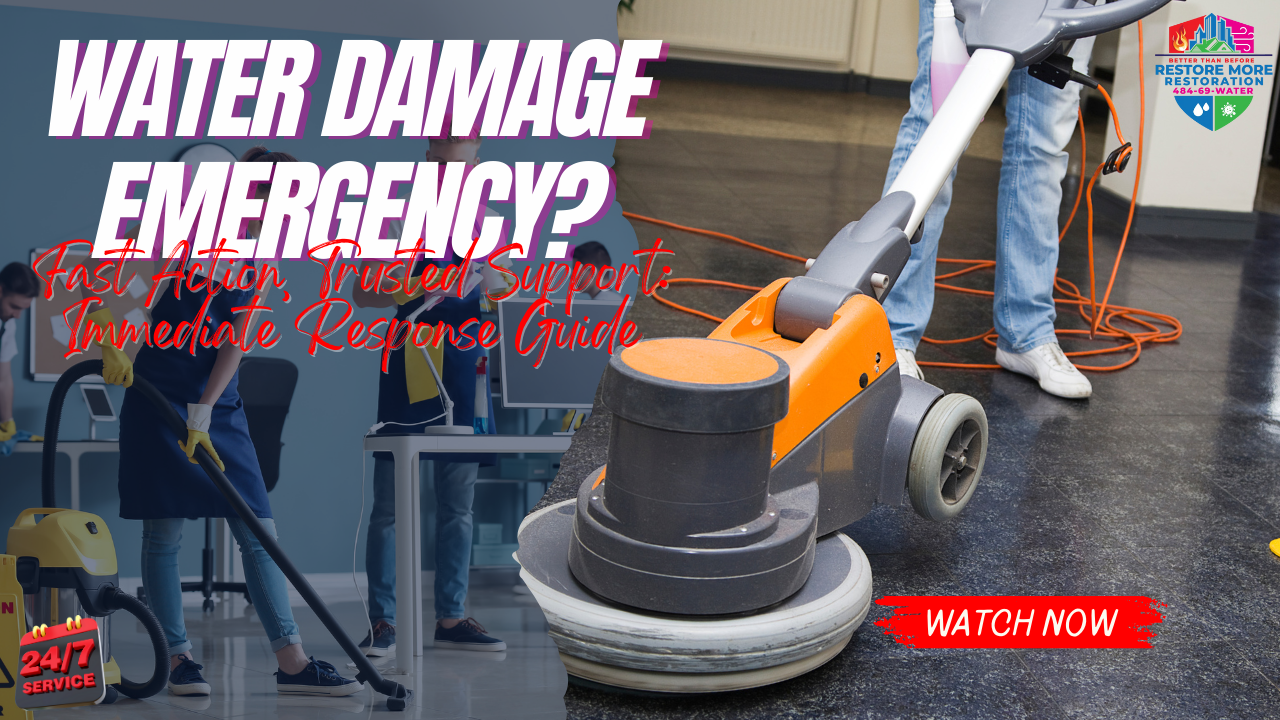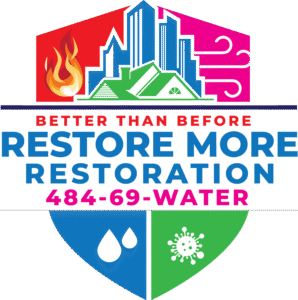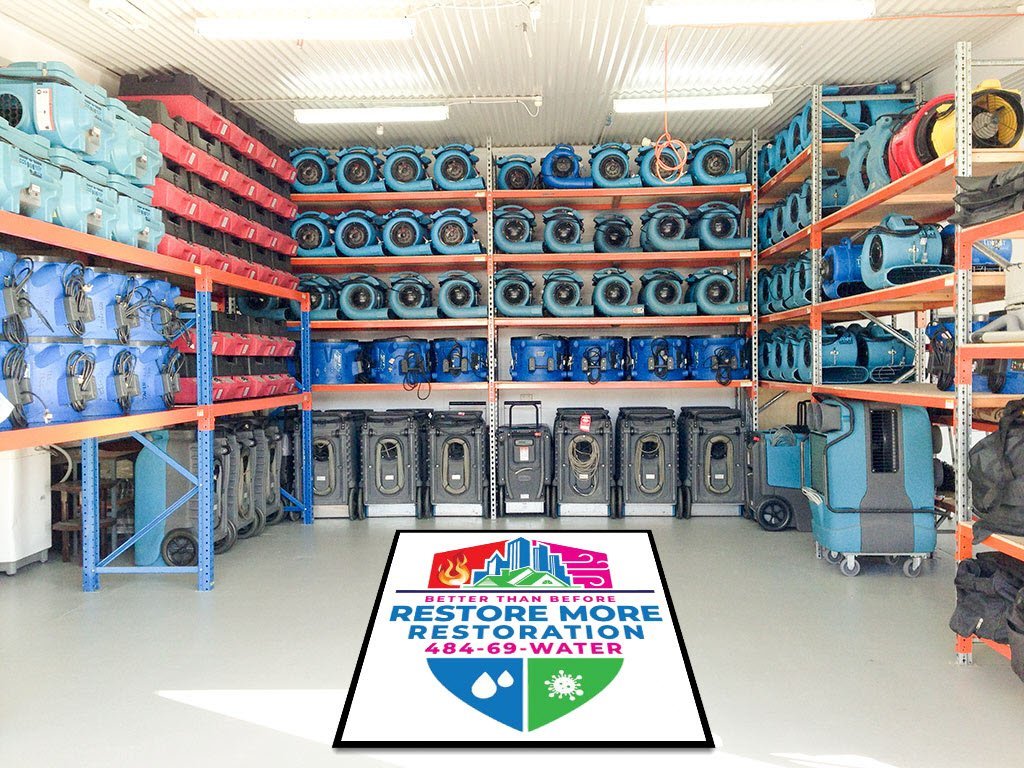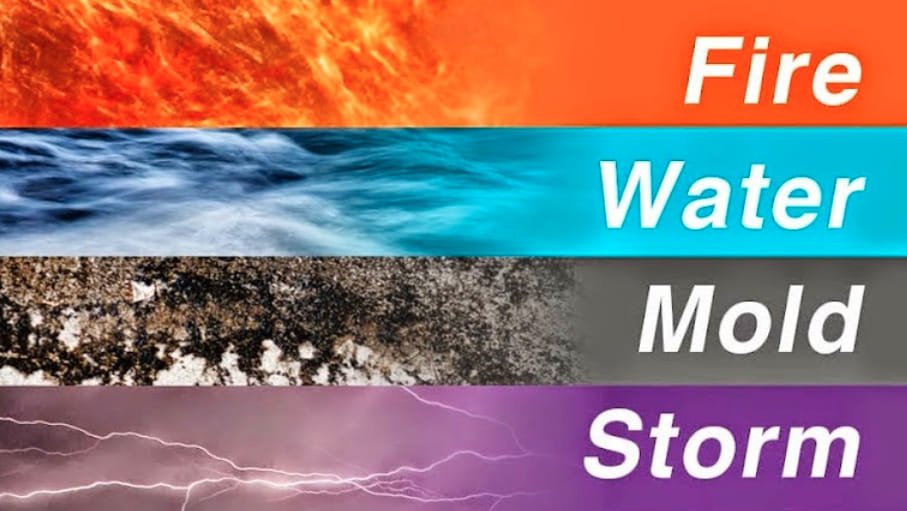Emergency Water Damage Response in Garnet Valley, Pennsylvania
When water damage strikes your Garnet Valley property, every minute counts. Whether it’s a burst pipe flooding your basement at 2 AM, storm damage during a weekend, or a water heater failure on a holiday, water damage emergencies don’t wait for convenient times. In these critical moments, you need immediate professional response from experts who understand that rapid action can mean the difference between minor repairs and catastrophic property loss.
At waterdamagecleanupgarnetvalleypa.com, we provide 24/7 emergency water damage response for Garnet Valley residents and businesses. Our trusted emergency partner, [RestoreMore365](https://restoremore365.com/), maintains round-the-clock availability with certified technicians ready to respond immediately to water damage emergencies throughout Delaware County. When disaster strikes, you’re not alone—professional help is just one phone call away.
Understanding Water Damage Emergencies
Water damage emergencies are time-sensitive situations that require immediate professional intervention to prevent extensive property damage, health hazards, and financial losses. According to the [Insurance Information Institute](https://en.wikipedia.org/wiki/Insurance_Information_Institute), water damage is one of the most common and costly property insurance claims, with rapid response being the key factor in minimizing damage and restoration costs.
What Constitutes a Water Damage Emergency
Not all water damage requires emergency response, but certain situations demand immediate professional attention:
**Immediate Emergency Situations:**
– Burst pipes or major plumbing failures
– Sewage backups or contaminated water intrusion
– Storm damage with active water intrusion
– Flooding from any source
– Water heater or appliance failures causing active flooding
– Roof leaks during storms
– Foundation breaches with water intrusion
– HVAC system failures causing water damage
**Why Emergency Response is Critical:**
Water damage spreads rapidly and becomes exponentially more expensive to repair with each passing hour. Within the first 24 hours, water can:
– Soak into building materials and furnishings
– Begin causing structural damage to floors, walls, and ceilings
– Create conditions for mold growth
– Damage electronics, documents, and personal belongings
– Compromise electrical systems and create safety hazards
The Science of Water Damage Progression
Understanding how water damage progresses helps explain why emergency response is so critical:
**First Hour (0-1 Hours):**
– Water spreads across surfaces and begins absorption
– Immediate damage to flooring materials begins
– Electronics and paper goods start suffering damage
– Safety hazards from electrical contact develop
**First Day (1-24 Hours):**
– Water penetrates deeper into building materials
– Furniture begins swelling and warping
– Metal fixtures start showing rust and corrosion
– Drywall begins deteriorating
– Odors begin developing
**First Week (2-7 Days):**
– Mold growth begins and spreads rapidly
– Structural damage becomes more severe
– Restoration costs increase dramatically
– Health hazards multiply
– Some damage becomes irreversible
**Beyond One Week:**
– Extensive mold contamination requires specialized remediation
– Structural integrity may be compromised
– Complete reconstruction may be necessary
– Health risks become serious
– Insurance coverage may be affected
Immediate Emergency Response Steps for Garnet Valley Residents
When water damage occurs in your Garnet Valley property, taking immediate action can help minimize damage while you wait for professional help to arrive:
Step 1: Ensure Safety First
**Electrical Safety:**
– Turn off electricity to affected areas at the circuit breaker
– Never enter standing water if electrical outlets or appliances may be submerged
– If you’re unsure about electrical safety, wait for professional assessment
– Keep family members and pets away from affected areas
**Structural Safety:**
– Be aware that water can weaken floors, ceilings, and walls
– Watch for sagging ceilings or bulging walls
– Avoid areas where structural integrity may be compromised
– If you suspect structural damage, evacuate and wait for professional assessment
**Health and Safety:**
– Assume all flood water is contaminated
– Wear protective equipment if you must enter affected areas
– Avoid contact with sewage or contaminated water
– Ensure adequate ventilation in affected areas
Step 2: Stop the Water Source
**If Safe and Possible:**
– Shut off the main water supply if the source is internal plumbing
– Turn off individual fixtures or appliances if they’re the source
– Place containers to catch dripping water
– Move the water meter key or shut-off tool to an accessible location
**When NOT to Attempt Source Control:**
– If the source involves electrical systems
– If the water source is external (flooding, storm damage)
– If stopping the source requires entering dangerous areas
– If you’re unsure about the safety of the situation
Step 3: Begin Initial Water Removal
**Safe Water Removal:**
– Use mops, towels, and buckets for small amounts of standing water
– Employ wet/dry vacuums for larger areas if electrical safety is confirmed
– Remove water-soaked materials like rugs and cushions if possible
– Open windows and doors to promote air circulation if weather permits
**What NOT to Do:**
– Don’t use regular household vacuums on standing water
– Don’t attempt to remove large amounts of water without proper equipment
– Don’t ignore safety precautions in favor of speed
– Don’t delay calling professionals while attempting DIY removal
Step 4: Protect and Document
**Protect Valuables:**
– Move furniture and belongings to dry areas if safe to do so
– Elevate furniture legs with blocks or foil if items can’t be moved
– Remove valuable items, important documents, and electronics from affected areas
– Cover furniture with plastic sheeting if available
**Document Everything:**
– Take photographs and videos of all damage before cleanup begins
– Document the water source and affected areas
– Make lists of damaged items and materials
– Keep receipts for any emergency supplies or services
– Note the time and date of the incident
Step 5: Contact Emergency Professionals
**Call RestoreMore365 Immediately:**
The most critical step is contacting professional emergency water damage restoration services. [RestoreMore365](https://restoremore365.com/) provides 24/7 emergency response to Garnet Valley with typical response times of 60-90 minutes for emergency calls.
**What to Tell Emergency Responders:**
– Your exact location in Garnet Valley
– The source and extent of water damage
– Any safety concerns or hazards present
– Whether utilities need to be shut off
– If anyone has been injured
– Your contact information and availability
RestoreMore365’s Emergency Response Process
RestoreMore365’s emergency response process is designed to minimize damage and begin restoration immediately:
Immediate Response (0-2 Hours)
**Emergency Dispatch:**
– 24/7 call center receives your emergency call
– Certified technicians are dispatched immediately
– Emergency response vehicle is equipped with extraction equipment
– Estimated arrival time is provided
– Safety assessment begins over the phone
**On-Site Arrival:**
– Technicians arrive with emergency extraction equipment
– Immediate safety assessment of the property
– Source identification and emergency shut-off if needed
– Initial damage assessment and documentation
– Emergency stabilization begins immediately
Emergency Stabilization (2-6 Hours)
**Water Extraction:**
– Powerful truck-mounted extraction units remove standing water
– Portable extractors address areas inaccessible to truck units
– Moisture detection equipment identifies hidden water
– Complete water removal from affected areas
– Initial moisture readings and documentation
**Emergency Drying Setup:**
– Industrial dehumidifiers are strategically placed
– High-velocity air movers create optimal drying conditions
– Moisture monitoring equipment is installed
– Climate control systems are established
– Initial antimicrobial treatments are applied if needed
Comprehensive Assessment (6-24 Hours)
**Detailed Damage Evaluation:**
– Comprehensive moisture mapping of the entire property
– Structural damage assessment and documentation
– Content evaluation and inventory
– Air quality testing if contamination is suspected
– Insurance documentation preparation
**Restoration Planning:**
– Detailed restoration plan development
– Timeline establishment for complete restoration
– Cost estimation and insurance coordination
– Specialized service coordination if needed
– Client communication and approval process
Types of Water Damage Emergencies in Garnet Valley
Garnet Valley’s geographic location, climate, and housing characteristics create specific types of water damage emergencies:
Plumbing System Emergencies
**Burst Pipes:**
Garnet Valley’s winter climate can cause pipes to freeze and burst, particularly in older homes or properties with inadequate insulation. These emergencies often occur when residents are away, allowing significant damage to accumulate before discovery.
**Water Heater Failures:**
Water heater failures can release 40-80 gallons of water rapidly, causing immediate flooding in basements, utility rooms, and adjacent areas. These emergencies require immediate water extraction and drying to prevent structural damage and mold growth.
**Sewer Line Backups:**
Sewage backups create immediate health hazards and require specialized emergency response. These situations involve contaminated water that requires professional handling and specialized cleaning procedures.
**Appliance Malfunctions:**
Washing machines, dishwashers, and refrigerator ice makers can malfunction and cause significant water damage, particularly when failures occur overnight or when residents are away.
Weather-Related Emergencies
**Storm Damage:**
Severe weather events can cause roof damage, overwhelm gutters, and drive water into homes through various entry points. These emergencies often occur during active storms when conditions are dangerous and access may be limited.
**Flash Flooding:**
Heavy rainfall can cause flash flooding that affects basements, crawl spaces, and ground-level areas. These emergencies may involve contaminated water and require specialized restoration approaches.
**Ice Dam Formation:**
Winter ice dams can cause water to back up under roofing materials and into homes, creating emergency situations that require immediate attention to prevent extensive interior damage.
**Wind-Driven Rain:**
Severe storms can drive rain through windows, doors, and other openings, creating emergency water intrusion that requires immediate response to prevent damage to interior finishes and contents.
Structural System Emergencies
**Foundation Breaches:**
Heavy rainfall or ground saturation can cause foundation cracks or failures that allow water intrusion into basements and crawl spaces. These emergencies may indicate serious structural issues requiring immediate professional assessment.
**Roof System Failures:**
Roof leaks during storms create immediate emergency situations that require temporary protection and rapid water extraction to prevent extensive interior damage.
**HVAC System Failures:**
Air conditioning system malfunctions can cause significant water damage when condensate drains become blocked or when equipment fails during operation.
Emergency Services Available 24/7 in Garnet Valley
RestoreMore365 provides comprehensive emergency services around the clock:
Water Extraction Services
**Truck-Mounted Extraction:**
Powerful truck-mounted units can remove thousands of gallons of water quickly and efficiently, even from challenging locations like finished basements and crawl spaces.
**Portable Extraction Equipment:**
Portable extractors can access areas where truck-mounted units cannot reach, including upper floors, tight spaces, and areas with limited access.
**Specialized Extraction Techniques:**
Different types of water damage require different extraction approaches, from clean water removal to contaminated water handling with appropriate safety protocols.
Emergency Drying and Dehumidification
**Industrial Dehumidification:**
Commercial-grade dehumidifiers create optimal drying conditions even in challenging environments with high humidity or limited ventilation.
**High-Velocity Air Movement:**
Strategic placement of air movers creates airflow patterns that maximize drying efficiency while preventing secondary damage to unaffected areas.
**Moisture Monitoring:**
Continuous moisture monitoring ensures that drying progresses effectively and that all affected materials reach appropriate moisture levels.
Emergency Structural Stabilization
**Temporary Roof Protection:**
Emergency tarping and boarding services protect properties from further water intrusion during storms or after roof damage.
**Structural Support:**
When water damage affects structural elements, temporary support systems can be installed to maintain safety while restoration planning proceeds.
**Utility Coordination:**
Emergency coordination with utility companies ensures that electrical, gas, and water services are safely managed during emergency response.
Content Protection and Recovery
**Emergency Pack-Out:**
Valuable contents can be quickly removed from affected areas and transported to climate-controlled storage facilities for protection and restoration.
**Document Recovery:**
Specialized techniques can recover important documents, photographs, and records that have been affected by water damage.
**Electronics Recovery:**
Coordination with electronics restoration specialists can help recover valuable electronic equipment and data storage devices.
Insurance Considerations for Emergency Water Damage
Understanding insurance coverage for emergency water damage helps ensure proper claim handling:
Immediate Insurance Notification
**Contact Your Insurance Company:**
Most insurance policies require prompt notification of losses. Contact your insurance company as soon as it’s safe to do so, typically within 24-48 hours of the incident.
**Emergency Documentation:**
RestoreMore365 provides immediate documentation that supports insurance claims, including photographs, moisture readings, and detailed damage assessments.
**Temporary Protection:**
Most insurance policies cover reasonable costs for temporary protection of property, including emergency tarping, boarding, and water extraction.
Coverage Considerations
**Sudden and Accidental Damage:**
Most homeowner’s insurance policies cover water damage that is sudden and accidental, such as burst pipes, appliance failures, and storm damage.
**Exclusions and Limitations:**
Understanding policy exclusions helps set appropriate expectations. Flood damage typically requires separate flood insurance, while gradual leaks may not be covered.
**Additional Living Expenses:**
If your home becomes uninhabitable due to water damage, most policies provide coverage for additional living expenses while repairs are completed.
Working with Insurance Adjusters
**Professional Documentation:**
RestoreMore365’s detailed documentation helps ensure that insurance adjusters have accurate information about the extent of damage and necessary restoration work.
**Scope of Work Coordination:**
The company works directly with insurance adjusters to develop appropriate scopes of work that address all covered damage while meeting insurance company requirements.
**Claim Advocacy:**
RestoreMore365’s experience with insurance claims helps ensure that property owners receive fair treatment and appropriate compensation for their losses.




